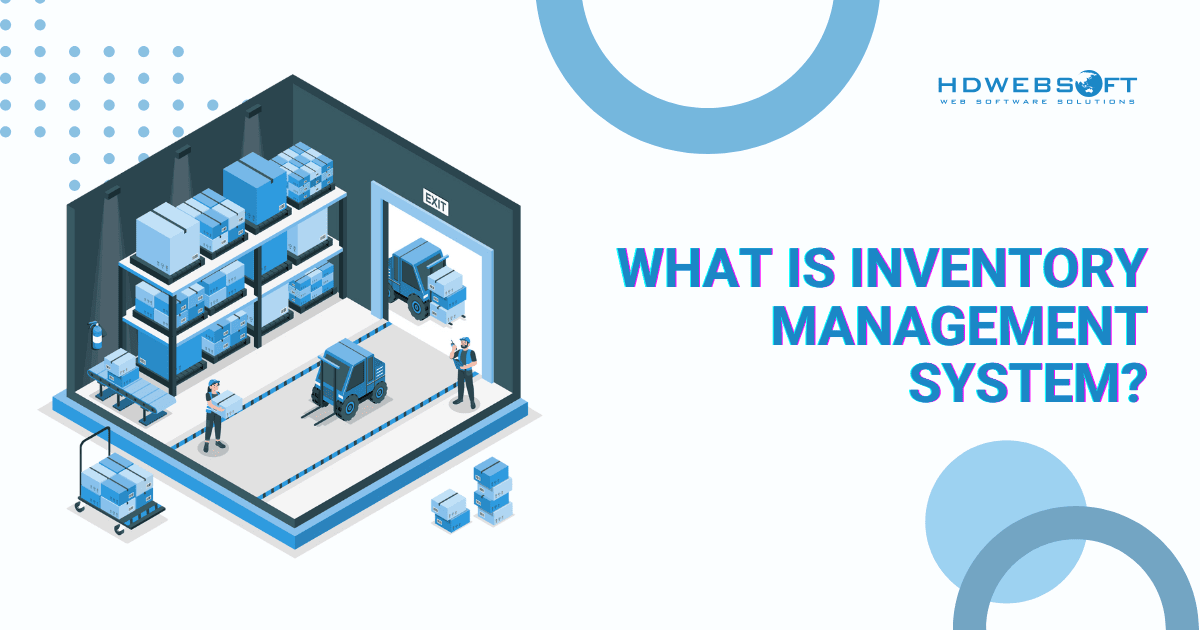
What is Smart Inventory Management System?
Smart inventory management is becoming a liberating solution in today’s fast-paced, digitally driven economy. As businesses grapple with increasing customer demands, complex supply chains, and growing competition, the burden of manual methods is no longer sustainable. Embracing advanced technology, a smart inventory management system provides the tools needed to free up time, stay efficient, accurate, and competitive.
In today’s article, we’ll discuss what an automated inventory management solution is and highlight its key advantages. Additionally, we’ll examine how it contributes to improved customer satisfaction and drives overall business success.
What is a Smart Inventory Management System?
A smart inventory management system is a technology-driven solution designed to monitor, track, and optimize inventory processes with greater efficiency and accuracy. Unlike traditional inventory methods that rely heavily on manual input, smart systems take a more advanced approach. They use automation, real-time data, and intelligent forecasting to ensure businesses always have the right stock at the right time.
Fundamentally, intelligent inventory management empowers businesses to make data-informed decisions, reduce human error, and improve responsiveness across the supply chain. As a result, companies can avoid costly overstocking, prevent stockouts, and maintain better control over inventory movement. All of which are critical for maintaining smooth operations and meeting customer expectations.
How It Differs from Traditional Systems
To truly understand the value of smart solutions, it’s helpful to compare them side-by-side with traditional inventory methods. Traditional systems often involve spreadsheets, manual counts, and delayed reporting, which can easily lead to errors and inefficiencies. In contrast, smart inventory management systems are designed to be proactive and dynamic.
Here, we’ve detailed the comparison of the key differences in the table below:
Core Technologies Behind Smart Inventory Management
What makes a smart inventory system truly “smart” is its integration of modern technologies. These innovations work together to automate tasks, analyze data, and provide actionable insights. Key technologies include:
- Artificial Intelligence (AI) and Machine Learning: These technologies enable systems to forecast demand and optimize reorder points. Moreover, they can learn from historical trends to improve future performance.
- Internet of Things (IoT): IoT sensors and RFID tags enable real-time tracking of goods throughout the supply chain. Ultimately, they enhance visibility and traceability.
- Cloud Computing: Cloud-based platforms provide centralized access to inventory data from any device. Thus, it becomes easier to manage stock across multiple locations.
- Big Data Analytics: By processing large volumes of data, smart systems can identify patterns, detect anomalies, and recommend data-driven improvements. Coupled with data visualization tools, these insights are presented in clear, intuitive dashboards. As a result, decision-makers can quickly grasp trends, spot inefficiencies, and act with confidence.
Together, these technologies create a highly responsive and smart inventory management ecosystem, one that evolves with your business needs and market dynamics.
Main Advantages of Smart Inventory Management System
Adopting a smart inventory system brings far more than just better stock tracking. It transforms the entire supply chain into a responsive, data-driven ecosystem. Below, we explore the key advantages that make smart systems a game-changer for modern inventory control.
Inventory Visibility in Real Time
One of the most significant strengths of smart solutions is their ability to provide real-time visibility. Instead of waiting for manual updates or end-of-day reports, managers can access live data on stock levels, item movement, and location tracking in real-time. This up-to-the-minute insight reduces the risk of overstocking or stockouts while also enabling faster and more informed decision-making.
Automation
Manual inventory tasks like reordering, stock reconciliation, and reporting are time-consuming and prone to human error. Smart inventory management systems use logistics automation to streamline these processes.
With features such as automated restocking, low-stock alerts, and AI-driven forecasting, businesses can achieve greater operational efficiency. This allows them to reduce labor costs, minimize mistakes, and save countless hours of manual work.
Are you planning to choose an AI-driven forecasting? Read A Guide to ML Prediction Model to make the best decision.
Efficient Inventory Control
With enhanced data insights and forecasting capabilities, businesses gain more precise control over their inventory. Smart solutions analyze historical trends and buying behaviors to help determine optimal stock levels, identify slow-moving items, and avoid waste. Consequently, this leads to leaner operations, lower holding costs, and more efficient use of warehouse space.
Supply chain disruption detection

In today’s volatile global market, supply chain disruptions can strike without warning. With that in mind, an intelligent system is designed to help detect and respond to these disruptions faster.
By monitoring supplier performance, delivery timelines, and external risk factors, the smart inventory management system can alert managers early. Thereby, they are given time to adjust procurement strategies or reroute logistics.
Higher customer satisfaction
Ultimately, every inventory decision affects the customer experience. Delays, backorders, and out-of-stock products can quickly erode trust and loyalty. With real-time tracking, automated processes, and accurate forecasting, businesses can keep products available exactly when and where they’re needed.
Notably, faster fulfillment, fewer mistakes, and reliable stock levels all play a key role in delivering the consistent service today’s customers expect. And that consistency is essential for long-term growth and customer retention.
Examples of Smart Inventory Systems in Business Success
Smart inventory system isn’t just a buzzword. It has become a proven strategy adopted by leading companies across various industries. Below are real-world examples of how global brands are putting smart inventory systems into practice and reaping the benefits.
Decathlon: Autonomous Inventory Robots
French sporting goods retailer Decathlon adopted a smart inventory management solution known as StockBot to improve store operations worldwide.
StockBot is equipped with RFID tracking and smart navigation capabilities. Accordingly, it can move autonomously through the store, collect inventory data, and update stock levels in real time. By automating these tasks, StockBot enables store staff to spend less time on stock control and more time assisting customers.
Kroger: IoT-Driven Smart Shelves
The largest supermarket chain in the U.S., Kroger, introduced EDGE smart shelves to personalize the in-store experience using IoT technology. These digital displays show dynamic information like pricing and promotions, and even connect with shoppers’ mobile shopping lists via Bluetooth.
The system streamlines the shopping process by highlighting listed items as customers navigate the store. Simultaneously, sensor data is collected and processed to support smarter, data-driven inventory decisions.
Polaris Industries: RFID Integration
At Polaris Industries, a U.S.-based automotive manufacturer, the use of RFID technology has significantly improved inventory tracking within production facilities. Workers now receive real-time updates on the precise location of units along the assembly line.
This shift toward inventory automation not only enhances counting accuracy but also cuts down on manual labor costs. As you may know, it’s a key benefit of adopting a smart inventory management system in manufacturing environments.
Dana Incorporated: Real-Time Visibility
Auto parts supplier Dana Incorporated implemented RFID-enabled inventory automation to gain real-time visibility and minimize manual errors. The system tracks items accurately throughout the supply chain, reducing production cycle time and enabling 100% traceability. With fewer data entry mistakes, Dana has streamlined its operations and improved overall inventory efficiency.
NLMK La Louvière: Predictive Analytics
Belgian steel producer NLMK La Louvière embraced intelligent inventory management to maintain optimal stock levels and improve order fulfillment.
The system uses predictive analytics not just to review current stock or order volumes. In addition, it evaluates more complex variables like demand fluctuations and lead time variability. This approach allows for more accurate forecasting and proactive inventory control. Thus, the company has achieved up to 200% more accurate shipping forecasts and 20% better route optimization.
DHL: Robotics and Real-Time Tracking
At its smart warehouse in Beringe, Netherlands, DHL leverages automation and robotics to revolutionize logistics. Stationary robots handle diverse package types with machine vision. Meanwhile, autonomous mobile robots work alongside staff to transport goods, improving both efficiency and workplace safety.
Concurrently, wireless tracking technology monitors the real-time movement of equipment and people. This helps the company optimize routes and reduce congestion during peak periods, a cutting-edge example of smart inventory management in logistics.
Ocado: Robot-Driven Fulfillment
Ocado is advancing its smart inventory management strategy through the use of On-Grid Robotic Pick (OGRP) technology at its automated fulfillment centers. These AI-powered robotic arms work alongside human teams to pick grocery items directly from storage grids and pass them on for packing.
In 2024, Ocado reported picking over 30 million items using OGRP, achieving significant productivity gains with only a limited number of robotic arms deployed. As the system scales, it’s expected to handle a larger share of order volume, improving both accuracy and operational efficiency. This level of automation and coordination showcases the full potential of smart solutions in high-volume e-commerce operations.
Conclusion
Companies across the globe are embracing smart inventory management as a key driver of operational efficiency and customer satisfaction. Organizations across diverse industries are adopting these advanced systems to gain real-time visibility into stock levels, enhance supply chain performance, minimize manual labor, and streamline inventory operations.
If you’re looking for a reliable, tech-powered approach to inventory management software, our team at HDWEBSOFT is here to help. Our experts are ready to craft a tailored, scalable solution that aligns perfectly with your business goals and inventory challenges.












